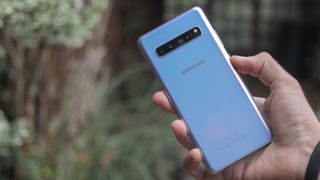Why you can trust TechRadar
Battery life
- 4,500mAh capacity battery
- It lasts a day and no more with moderate use
- Wireless and reverse wireless charging support
The Samsung Galaxy S10 5G comes with a huge 4,500mAh battery, giving it one of the biggest capacity cells around. That’s hardly surprising, given the fact there’s that massive QHD+ display, along with a heap of power under the hood and 5G connectivity to keep ticking over.
From a software point of view, there’s plenty to help you keep power consumption in check, with four battery modes in the settings: High Performance, Optimized, Medium Power Saving and Maximum Power Saving.
There’s also an Adaptive Power Saving option you can activate, which sets the power mode automatically based on your usage patterns, to save power when it’s not needed.
Samsung claims the Galaxy S10 5G will be able to last for 24 hours on a single charge, but we had mixed results in our time with the phone.

We used the Samsung Galaxy S10 5G for three days in South Korea, where we were using the handset’s 5G connection as a hotspot for our other devices for several hours each day, and the battery life was impressive. We managed to get through a whole day (7am until midnight) on a single charge, with still double digits left in the tank by the time we got to bed.
On the other hand, the Galaxy S10 5G we tested in the UK couldn’t get us anywhere close to such a long day with intensive use, especially when we used the camera and hotspot liberally.
This could come down to chipset variances. The global version features an Exynos 9820 processor, while the US version features a Snapdragon 855. We’ll cover that in more detail on the next page - but there have been reports of discrepancies across heat management and battery performance between chipsets.
Still, even with our Exynos review device, with regular use, we were able to make it from 7am to 8pm with about 15% left in the tank.

The S10 5G can be charged via USB-C, for up to 25W fast charging, and you can charge it up wirelessly for up to 15W fast charging with compatible fast wireless charging pads.
The phone can even be charged from another S10 5G thanks to Wireless PowerShare, which lets you wirelessly charge other Qi-compatible devices by placing them on any S10 device and activating the feature.
This means you can plug the S10 5G into the mains via a cable, and then effectively use it as the priciest wireless charging pad around, topping up other devices, such as the Galaxy Watch, Galaxy Buds, and other phones you or your friends/family may have.
Camera
- Features six cameras
- Depth sensing cameras on the front and back
- Excellent photo and video quality
The Samsung Galaxy S10 5G is the only S10 handset to boast four rear cameras, and it’s only the second device from the brand to pack this number (the other being the Galaxy A9 2018).
The first three cameras are identical to the triple-sensor setups on the Galaxy S10 and S10 Plus, with a main 12MP variable-aperture camera (f/1.5 or 2.4), a 16MP 123-degree ultra-wide snapper, and a 12MP telephoto lens.
The fourth camera on the Galaxy S10 5G is the most interesting: a 3D depth-sensing camera, also known as a time-of-flight (ToF) camera.

ToF cameras aren’t new, we’ve seen them in the iPhone X, LG G8 ThinQ and Huawei P30 Pro, for example.
What ToF provides is detailed, accurate depth sensing, which is helpful for face recognition, 3D imaging, VR (virtual reality) and AR (augmented reality).
It can also help to optimize the photos taken by the other cameras, providing better background blurring in Samsung’s ‘Live Focus’ portrait mode. While this was cool on the rear camera, we actually found ourselves using it most on the front camera, shooting Live Focus selfie videos.
As with portrait mode, this effect clearly creates software-based blur, however, people we sent this blurred background footage to were still impressed - one even inquired as to where she could buy the phone, just for that feature.
So while photographers and videographers may well balk at artificial background defocus, given how prevalent it is in photos now, this kind of video could well be one of the next big trends.
A point to note, using Live Focus video heats up the phone and drains the battery very quickly, so be mindful to be sparing if you won’t be charging your S10 5G any time soon.
As for shooting options, it’s predictable but comprehensive. Modes include Instagram, Food, Night, Pro, Panorama, Live Focus (Portrait), Photo (Auto), Video, Live Focus Video, Super Slow-mo, Slow Motion, and Hyperlapse.

The S10 5G’s camera is easy to use, and jumping between the main lens and the other sensors is quick thanks to an on-screen toggle.
Moving all the way to the ultra-wide sensor, we were impressed by just how much of our surroundings the Galaxy S10 5G was able to see, though, this comes loaded up with a fair bit of barreling, giving a fisheye GoPro style distortion. As with the Sony Xperia 1 though, you can dive into the settings and correct for the barrel distortion at the expense of some of that ultra-wide field of view.
When it comes to quality, if you want a killer point-and-shoot experience, the S10 5G delivers. There’s a smart scene optimizer so it can tell you if it sees a cat, a dog or plants, but even if you forget it’s there and just snap away, you’re likely going to get a decent shot.
This also has a lot to do with Samsung’s Auto HDR feature, which delivers strong detail across a scene, without any blown-out areas, even in challenging conditions.
Photos also deliver plenty of clarity, too. While the phone’s pixel-count doesn’t rival that of the Asus ZenFone 6 or OnePlus 7, for example, it’s still able to produce images that can easily be printed off and blown up, provided the lighting is right.

When the lights drop, the S10 5G does struggle a bit, despite the wide aperture. With phones like the Huawei P30 Pro and Google Pixel 3 producing long-exposure night modes that can literally see in the dark, the Galaxy S10 5G’s night mode lags behind. While it’s significantly better than the iPhone XS and XS Max, therefore, it’s still not a super low-light champion.
Selfies look very good, even when you don’t engage the ToF sensor and just use the 10MP main front lens. The S10 5G is one of the only phones around with front-firing autofocus, and there’s a software-based wider angle that can be activated to use more of the front camera’s sensor.
While there’s no front flash, the screen flash is powerful and across lighting conditions the S10 5G is one of the better selfie cameras on the scene. The fact it can also record up to 4K, 30fps video is just the icing on the cake.
Video captured on the S10 5G looks very good. It’s smooth even when handheld, is captured at up to 4K, 60fps from the rear camera, and manages to perform competitively well across lighting, with a healthy amount of detail and respectable dynamic range.
The 960fps super slow motion option has also been improved, capturing single bursts and laying music against them, which is novel, a bit weird, but fun - making slow-mo clips easy to slot into other projects. They still only really look good if you’re shooting in very well-lit conditions, but if indoors, the regular 240fps slow-mo feature suffices.
Across the board, therefore, the Galaxy S10 5G, like the rest of the S10s, is an excellent camera phone, even if it isn’t the very best in low light.
Camera samples











Current page: Battery life and camera
Prev Page Introduction, design and display Next Page Anything else I should know?Basil Kronfli is the Head of content at Make Honey and freelance technology journalist. He is an experienced writer and producer and is skilled in video production, and runs the technology YouTube channel TechEdit.

